|
 |
|
|
| 12th October 2004 Depart London LHR with Air China
CA938 20:25, arrive 13:10 next day. Overnight on aircraft. |
| 13th October Arrive Capital Airport at lunchtime. After
clearing immigration and customs you will be met by a guide from the CTSIC
national centre, who will look after you for the whole tour. Transfer to your
accommodation in the Beijing Hotel. The rest of the day is free. Old China
hands may wish to revisit known haunts, or just walk locally. Of course you may
simply want to rest and relax after a 10 hour flight |
| The Beijing Hotel
is one of the luxury hotels of Beijing. It is only a couple of minutes walk
from Tiananmen square and the Forbidden City, and one entrance opens into
Wangfujing, a major shopping centre. It has a past steeped in the history of
Beijing, going back to 1900, although it’s now fully modernised and
comfortable. A tape covering the main events of its historical past plays
almost constantly on a couple of televisions close to the main Lobby, and is
worth a few minutes looking at if time allows. |
|
| 14th October This is the day of departure for Xi’an. After
breakfast there will be time for a stroll or a small group may wish to visit
the Temple of Heaven, about 20 minutes away by taxi. The group will join
together for a traditional roast duck lunch, after which there should be time
for a visit to the Forbidden City before setting off for Beijing West station
and the overnight train to Xi’an, departing 17:12, arrive 06:45 next day. |
Chinese trains
There are usually three classes of accommodation on long-distance Chinese
trains.
1. Hard seat is not recommended for journeys of more than an hour or two unless
one is fairly masochistic or desperately short of money.
2. Hard sleeper is basically couchette accommodation with open compartments of
six berths each.
3.Soft sleeper class has compartments with proper bed linen, four to a
compartment (2 upper, 2 lower) and there are washrooms plus both Western-style
and squat toilets at the end of the carriage. Sexes are not segregated, and if
a party isn’t a multiple of four you may be sharing with complete strangers,
although the atmosphere is usually a pretty gregarious one. if a compartment is
mixed it is customary for the men to hover in the corridor while the ladies go
to bed.
This tour uses soft sleeper, which is as comfortable as scheduled trains get.
|
|
|
| Introduction to Xi’an.
Xi’an is the modern city which developed from Chang’an the old Imperial Capital,
and destination(or origin) of the Silk Road caravans over a period of at least
2000 years. It is a large and bustling city (around 7 million population) but
the traces of antiquity are all around, indeed several sources make the point
that the Imperial City used to compete for the title of the world’s greatest
with Rome and Byzantium. It marks the easternmost extent of the march of Islam
in the 7th and 8th Centuries, and certainly the small streets and area round
the Great Mosque have the feel of an Arabic rather than a Chinese culture.
This area is the real heartland of Chinese civilisation, and the relics of the
past are immense, both in quantity and distribution. Xi’an itself is only the
centre of a civilisation cradle in the particularly fertille valleys of the
Yellow River and its tributary the Wei, which gave its name to a dynasty of
emperors ruling during the fairly chaotic 4th and 5th centuries AD following
the decline of the Han.
A full history would take many pages, and probably be read only by the
specialist, but for our purpose there are two major periods of interest. After
a long period of turmoil or dispute over several hundred years (the “Spring and
Autumn” and “Warring States” periods) the country was united by the autocratic
emperor Qin Shihuangdi the first ( and effectively the only) emperor of the Qin
dynasty of 221 to 206 BC. His achievements are immense, and so was the tomb he
had built for himself – it is supposed to be the biggest tomb setting in the
world and is effectively a sizeable hill as seen from the road. He expired
exhausted after about 11 years and his heir lost the lot in the next four years
to rebellions caused by their autocratic style of rule. His main memory is
through the Terracotta Warriors of recent fame which the tour will visit (see
below).
The conqueror of the Qin founded the Han dynasty which kept China more-or-less
peaceful and developing for over 400 years (to 220 AD), and the first Han
emperor established Chang’an as the Capital. The Han pushed the borders of a
unified China westwards to round about its present Western borders, and the
stability which resulted was a major influence on trade along the Silk Road,
and although another period of virtual civil war followed the Han conditions
remained stable enough for trade to continue and flourish.
The real heyday of the Road was in the Tang dynasty of 618 to 907 AD. At times
this dynasty controlled not only China within its modern boundaries (Tibet
excepted), but Central Asia all the way to Iran. Dr Susan Whitfield’s book Life
along the Silk Road brings this period when Chang’an flourished to life and is
well worth reading.
After the Tang China again broke up into warring factions, only reuniting when
the Mongol invaders established unity by force as the Yuan Dynasty in 1279, but
by this time the Silk Road (at least in its traditional form) was consigned
pretty much to history with trade routes taking to water to reach the West (the
way Marco Polo returned, in fact) rather than the now almost impossible land
journey.
|
|
| 15th October Arrive Xi’an 06:45. Transfer to Le Garden Hotel.
It is possible that the hotel isn’t full, in which case they may well have the
party’s rooms ready and will let us use them immediately. More likely is that
we will have to wait until later in the day when previous guests have departed,
but we will have ensured that rooms are available for showering, changing etc,
on a basis of roughly 5 men (or women) using a room. Breakfast will be taken in
the hotel, then a day in the City Activities will include visits to the city
walls, forest of steles, the Grand Mosque and the Big Goose Pagoda. Overnight
at the Le Garden Hotel, Xi’an.
It is not intended to comment in detail on the sights to be seen every day – the
suggested guidebook (and indeed others) do that very well, and a lot more
detail will be added by the tour guide. Some overall background notes will be
given here to put things in context.
The City Walls are remarkable, although relatively recent in Chinese terms,
dating from the Ming Dynasty (!4th Century AD) and restored over the years.
They are almost nine miles (14km) long, 40 ft (12m) high, and a small arm can
walk abreast on them. Close to them are the Bell Tower (where an enormous bell
was rung at dawn and to mark the passing hours) and Drum Tower (from whence the
curfew was sounded). These are also 14th Century, and while the Great Bell is a
replica, visitors can ring it for a small fee, to the confusion of anybody
listening and who can hear it above the traffic noise.
Close to the walls is the “forest of Steles”, a remarkable display of stone
tablets and other permanent writings with enormous historical interest, in
which the scholar can trace the development of Chinese and Buddhist thought. In
fact Xi’an is a place where ancient religions met (and by all accounts
co-existed in reasonable harmony), and one on the exhibits in the Forest of
Steles is a tablet with a small cross and engraving on the Nestorian Christian
Church, dating from the 780s. A fair number of other Silk Road artefacts are to
be found here.
The Great Mosque is much older (late 8th Century, but present layout also from
Ming times) The streets around it are worth an exploration, time permitting,
and give an impression more of Muslim Central Asia than of China.
Finally, the Big Goose Pagoda represents the Buddhist religion. It was built for
(or in honour of) Xuan Zang, one of the most indefatigable Chines travellers
and emissaries of the emperor, on his return from India round about 650 AD.
Clearly the 7th and 8th Centuries at the height of the Tang Dynasty were a time
of religious tolerance and indeed refuge of religious minorities. Again see
Susan Whitfields book for more on the time.
|
| 16th October Day of activities around Xi’an, based on the
Terracotta Army, Banpo site (if re-opened) and Hot Springs. At the time of
writing the Banpo Neolithic site was closed for renovation, but should be
reopened by the time of the tour. Overnight at the Le Garden Hotel, Xi’an. |
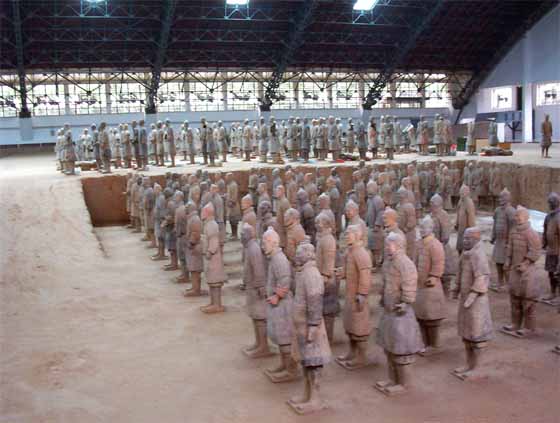 |
| Picture: the terracotta warriors. This is part of Pit One, a bit we called the
“sick bay” where the broken figures are put back together very carefully before
being put back into their original place. This restoration work will probably
go on for several decades yet.
If there is one thing on this tour that needs no introduction it is the
Terracotta Army. The tomb of Emperor Qin Shihuangdi (see above) is about 22
miles outside Xi’an, and round his burial mound are a number of interesting
sites of the period. It was normal for somebody of his status to be accompanied
to the afterlife by a retinue according to that status, including, very often
an army for maintaining that status. This could indeed be real soldiers buried
alive, but in this case it was thought that none could be spared from the
tribulations of this life and earthenware (terracotta) warriors were produced
instead. The burial was destroyed and lost in antiquity, rediscovered about 30
years ago and is being restored to its former glory. There are probably over
7000 warriors in the pits, each life-size and probably modelled on an actual
soldier of the time (210BC).
Moving further back in time we can see the remains of the Banpo Neolithic
village (about 7000 years old) well preserved in its own museum. It is as
complete a site as may be found almost anywhere, and gives enormous insights
into life in prehistory in China. Not directly related to the Silk Road, but
difficult to pass by if it’s open. At the time of writing it isn’t; it’s closed
for renovation but is due to be reopened by the time of the tour.
The Huaqing Hot Springs (a favourite bathing spot of the Tang Emperors and their
lady friends) will conclude an interesting day.
|
 |
| Picture: a view of Huaqing hot springs, where emperors cavorted and
Generalissimo Chiang Kai Shek met a bit of difficulty rather more recently. |
| 17th October Morning visit the Shaanxi Provincial History
Museum. After lunch, fly to Jia Yu Guan Pass HU219 15:30 arrive 18:40. Stay at
Jia Yu Guan Pass Hotel
Museums may sound dull, but I suggest you reserve judgement on this one. I also
suggest you carry at least a skeleton chronology of Chinese dynastic succession
in your head or pocket. The place is built in Tang style, and the halls will
take you through the roller-coaster of China’s rise, decline and rise again
through its 7000 year history, as it appeared in the Yellow and Wei River
valleys. I won’t begin to suggest what to look for, but it’s got a wonder or
two for nearly everybody. It will take a good couple of hours just to skim the
main features, and ideally more to linger a bit at the more interesting (for
you) sections.
We now move on. Unfortunately we can’t cover the whole Road (see the “important
principle” above) and we propose to concentrate on the Tarim Basin and trace
some of the footsteps of Aurel Stein. This means missing out the Hexi Corridor
and flying to the gateway to the Tarim at the Jiayuguan Pass and Fort, arriving
at a civilised time for an evening meal and relax.
|
| 18th October Visit the Jiayuguan fort (last on later Great
Wall), Overhanging Wall and Wei dynasty graves with painted bricks. Take the
coach to Dunhuang, via Anxi, and ruined city of Qing dynasty. This part of the
day will be spent mainly sitting watching the Gobi Desert go past. Stay at
Dunhuang Silk Road Hotel. This will be a fairly long day, but worthwhile.
The Jiayuguan Fort was a major outpost at the very end of the later (Ming) Great
Wall, for a long time marking the boundary between metropolitan China and the
outer territories which China controlled but didn’t really regard as quite
civilised (I use concepts slightly loosely here). You might read Mildred
Cable’s account of the fort and its uses before visiting if you have the book.
The first section “On the Threshold of the Desert” gives an account of the fort
and its inhabitants about 80 years ago, at a time when it still served its
original purpose to a large extent.
|
|
|
| Picture (copyright Robert Youngs): a wider view of the Last Fort showing the
Gate of Sighs and the gravelly/stony desert.
From the fort the Wall runs off in three directions. The main part runs back
into China, and continuously (if nowadays occasionally ruinously) to the sea
getting on for 1500 miles away. A second shorter length runs to the mountains
where it stops as they get too high to get round it; the third sections goes to
a small tower overlooking a virtual precipice into a deep channel from the
mountains. This is the so-called “overhanging Great Wall” and marks the real
end of the Wall.
From here we take coach for Dunhuang, the name meaning “Blazing Beacon”, from
the chain of beacons used as a warning of approaching danger during the time
when this was a military outpost of the Empire. Dunhuang is about 350 km away
from Jiayuguan, but the journey is mainly along good highway. All the same this
will take several hours, but the ever-changing Gobi landscape holds its own
fascination. On the way (time permitting) we will stop at Wei Dynasty tombs – a
massive cemetery with a single tomb open for visitors. It is empty (although
wooden coffins and other grave goods are in the little above-ground museum),
and the main attraction is the remarkable painting on the bricks of the burial
chambers. Each painting occupies a single tile, and they show scenes of
hunting, butchery and other day-to-day activities of the time. One brick
painting, of a horseback courier holding a letter, has been used a symbol for
the Chinese Post Office. A ruined city of the Qing Dynasty (much later, around
1750 to 1800) will also be looked at if time permits.
|
| 19th October Get up early and walk to Minsha Dunes (about 1
km). Climb the dunes, probably in bare feet, to catch the sunrise. Walk down
and along (15 to 20 minutes) to the Crescent Moon Lake, and back to a lateish
breakfast. The balance of the day is a rest day, and this hotel is a
first-class place to have one, or individuals or small groups can take taxis
into Dunhuang for pretty good arts and crafts, oasis foods etc, or possibly the
Western Thousand Buddha caves for a small group who want to do that. Stay at
Dunhuang Silk Road Hotel.
The Silk Road (Dunhuang) Hotel is fairly new, and built in the style of a Ming
Dynasty palace. It is light and airy, and I know of few better places for
simply sitting in the lobby and sipping a beer or two. At this stage in the
tour some relaxation time is in order, and most of this day is devoted to just
that.
An early start is called for, although not too early since we are now at least
an hour by the sun West of Beijing, although Beijing time is still observed.
Anyway a walk of a kilometre or so in the morning twilight will bring us to the
Minsha Dunes, or singing sands. A certain amount will depend on conditions, but
I would expect us to be able to climb the dunes in the twilight – bare feet is
best – and watch the sun rise over the more distant sands. This can be a
magical time. There may well be large numbers of other tourists around – it’s
very popular with Japanese and Korean groups - but they all mount camels at the
entrance and lope off in long strings to watch the sun come up in a cacophony
of noise a mile or two away. We will see their camel chains passing below us as
we sit on the dunes watching for the sunrise. The year is getting later, so
warm clothing will probably be needed.
|
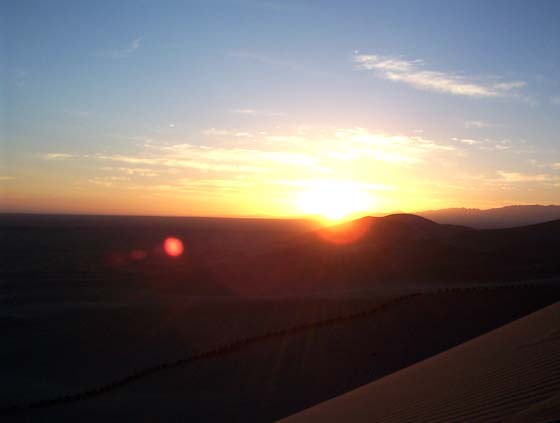 |
| picture: sunrise over Mingsha dunes.
The Lake of the Crescent Moon is described by Mildred Cable in a passage in “The
Lure of the Gobi” from her book The Gobi Desert. “the skill of man made the
Caves of the Thousand Buddhas, but the Hand of God fashioned the Lake of the
Crescent Moon” is the old Dunhuang saying. The lake was, she was told, “more
beautiful than words can tell”. It lies at the bottom of the dunes and is fed
by a perpetual spring, so that the water-level stays constant, and (in her
times) the only human activity there was an isolated shrine tended by a priest
as a place of peace and prayer. The sand dunes behind are probably the
“rumbling sands” described by Marco Polo, which produce a deep rumbling if
anybody slides down them in the right place. Nowadays large numbers of tourists
try to find the rumbling for themselves, and at peak times the place becomes a
bit like Blackpool beach, but get there in the early morning before they do and
the peace and beauty of the place can still be seen and its calm felt.
|
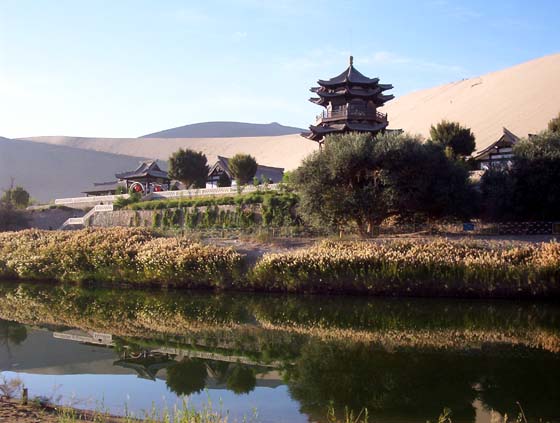 |
| picture: Lake of the Crescent Moon, Mingsha dunes in background
Back to breakfast and (it is suggested) a peaceful day. For those who can’t sit
still for more than a couple of minutes, or who prefer activity to
contemplation there is much that can be done, and local advice will be given.
Taxis to town (a couple of miles away) cost a pound or so, and an early evening
excursion has something to commend it for local sights and produce. Otherwise
the hotel beer is very good (and very cheap), so a contemplative bottle or two
taken seated on Ming-style chairs in the massively tall and airy hotel lobby
has a great deal to commend it.
|
| 20th October Visit to the Mogao grottoes (the Institute’s
specialist guide will be available). In the evening take the train to Turpan
K889 20:26, arrive 06:16 next day. Overnight on train (soft sleeper).
For many today will be the highlight of the tour. If you have been following the
events at the British Library exhibition you will know that the “library” from
the Mogao grottoes in Dunhuang is one of the most exciting hoards of ancient
documents ever found. You will also have heard of the somewhat dubious way most
of it found its way to Western museums and libraries. Much more is said in
various books, and you may want to look at (for example) Peter Hopkirk’s
“Foreign Devils on the Silk Road”
Be that as it may, the grottoes themselves are still magnificently decorated and
are now set in a small park which mitigates the heat of summer, at least
partly. Again, this is a place with enormous numbers of tourists, but it rarely
seems uncivilised. Guided tours are the order of the day, and we expect to have
the specialist guide attached to the Dunhuang research Institute who will give
us some extra insights into the life and times of the caves.
Together with a visit to the museum on the same site, where several caves have
been copied to take some of the pressure off the originals, this visit will
take most of the day. After dinner we will take the sleeper train to Turpan,
also known as Turfan or Tulufan to the Chinese who have no “r” in their range
of sounds.
|
| 21st October Arrive in Turpan and transfer to hotel. As in
Xi’an rooms will only be available later, but facilities for showers,
freshening up and changing will be available. Breakfast in hotel. The days
activities will include Visit to the Astana graves (cemetery for Gaochang),
Karez system of irrigation, Emin minaret and mosque. Stay at Oasis Hotel
|
|
The oasis of Turpan
Turpan (or Turfan or Tulufan) is a genuine oasis settlement. It is well-known
as the second lowest point on earth (the Dead Sea being the lowest) at about
140 metres below sea level. Its climate is extreme, up to 47 degrees in summer,
down to minus much the same in winter. It is also extremely dry, with no more
than a few millimetres of rain or snow a year. This dryness is responsible for
the preservation of the very old cultures which give the oasis so much
interest, and also make life here so precarious. There is abundant water some
50 km away in the mountains, and an ingenious system known as karez is used to
keep the settlement alive. The oasis has been a settlement and staging post
from ancient times, as witnessed by the remains of ruined cities such as
Gaochang and JiaHe, and their cemetery, the Astana graves.
Turpan is famous for its fruit, and is said to produce the best sultanas and
raisins in China, and possibly the world. The grapes are abundant, sweet, and
not used for wine – a little is made and it’s an interesting but acquired
taste. fruit is dried by the hot autumn winds in special brick-latticed drying
house which are seen everywhere. Along with Hami melons, which are even more
legendary, this was a fruit supply for the emperors of old.
|
|
 |
| Picture: sorting Turpan sultanas by hand to remove debris. – open-air wholesale
market. |
|
The Karez system of water supply
The Karez system of irrigation is very old indeed. It probably started in
Persia around 2500 years ago, and was certainly found in Turpan area by 2200
years ago. Basically a head well is drilled down to the water table near the
mountains, and other wells at about 30 - 50 metre intervals from there down to
the town, the wells being connected by tunnels., so that a single channel flows
at water-table depth all the way down to the town. It takes water from the
mountains and augments that from the water table all the way down so that most
karez flow quite strongly as they reach the town, where (in Turpan, anyway) the
water is close to the surface as it reaches the town. The tunnels also make
sure that there is little or no loss by evaporation as the water comes from the
mountains. We will visit one of these karez as it comes to the surface.

picture: Karez water channel near its mouth. The basket on the rope was lowered
into the tunnel to be filled with earth during the annual cleaning of the
channel.
|
We are now in Xinjiang, the “new territories” of China, and an area where
Islamic influence is strong. The Emin minaret and mosque are good examples of
Islamic influence and art. It was started in 1777 by Emin Khoja, the hereditary
ruler of Turpan, and completed by his son. It uses local materials well (mainly
mud bricks) and has a beautiful, almost stark simplicity and peace. The minaret
is less than fully stable, these days, although not about to fall down, so it
can’t be climbed, but the views of and from the mosque are well worth the
visit.
|
| 22nd October Visit to the Gaochang ruined city,
the Flaming Hills, and other sites of interest as time permits. Stay at Oasis
Hotel
Gaochang is an ancient city close to the present town in Turpan, made of mud
bricks and rammed earth. It dates from the second century BC and in its heyday
(roughly 2nd to 5th centuries AD) it was a major centre of power and influence
in the region, and a significant trading post. It was also very cosmopolitan,
and a stronghold of Manichaeism. It declined gradually as the Silk Road
declined and was eventually over-run by the Mongols in their sweep through on
the way to power as the Yuan Dynasty. Much of the ruins still survive because
of the dryness of the atmosphere, the main threat being farmers who see the mud
walls as fertile soil for their fields.
|
| 23rd October Coach to Urumqi, afternoon in the
City, visiting the regional museum for an insight into the history and
prehistory of the Tarim Basin, late evening flight to Kashgar. Stay at Qiniwaka
Friendship Hotel
The coach trip to Urumqi is fairly short (probably about 2.5 hours) but full of
interest. At this point we are leaving the Silk Road proper for a bit (although
no doubt various routings did go this way) to catch a plane to Kashgar at the
other end of the Tarim Basin. We haven’t time to take the train or go by road,
unfortunately, and in fact both of these can get a little tedious to all but
the committed train or desert aficionado. We will travel along the main highway
from Shanghai to the Kazakhstan border, at this point being 4000km from
Shanghai. Again the ever-changing Gobi will be present, with a pass through
mountains and one of the biggest wind farms on the planet. See Mildred Cable
again about the region “Anxi - where the great winds blow”. There are
gale-force winds most days, and there are central refuges where high-sided
lorries turn off nose-to-wind and wait for it to blow by.
The Urumqi regional museum was being renovated last time I was there, and this
is a major job so it may well still be closed. However, many of the most
important exhibits are being shown in a temporary display in one of the halls,
and even this small sample takes a good hour and a half to look at. The Tarim
Basin is very dry, as already mentioned, but before drying up was a cradle of
civilisation for much of Central Asia. There are old cities everywhere, some
excavated, some not, and many of the recovered artefacts are in Urumqi. It may
sound slightly gruesome to think of a display of desiccated human corpses, but
in fact these give an excellent insight into the history of the area, together
with all the everyday utensils and grave-goods from the Astana graves, among
other places.
The city of Urumqi itself is said to be the farther from the sea than any other
city in the world, although the same is said about Kashgar as a town. It is
also described as a Han (Chinese) city in a Uighur sea, from the fact that in
Xinjiang the Chinese are mainly city dwellers, the Uighur mainly rural. If time
allows it is interesting to wander a little in the middle of the (rapidly
modernising) city and see how the two cultures interact.
The flight to Kashgar is likely to be a late one (we haven’t got the timetable
at the time of writing) and the return from Kashgar even later, perhaps in the
wee small hours of the morning. In this case dinner will be taken in Urumqi and
we will go straight to the hotel and bed.
|
24th October City sights – Id Kah mosque,
Fragrant Concubine mosque, bazaar, street of craftsmen etc. Stay at Qiniwaka
Friendship Hotel
Kashgar (Kashi to the Chinese) is very much a central Asian city, although the
Chinese predilection for rubbing things out and starting again is felt even
here, and parts of the city are changing rapidly. Nonetheless Islamic influence
is profound, and most of this day will be spent in exploring the sights of one
of the oldest trading posts in the region. After splitting to go round the
Taklamakan desert, either to North or South, the strands of the Silk Road came
together again here. From the other direction the various routes over the
mountains also met at Kashgar. In general caravans started and finished at
Kashgar, with camels being used in the deserts to the east, horses and mules to
go over the mountains westwards. As mentioned traders rarely travelled the
whole length of the road, and Kashgar was a centre for selling on what had been
brought in and purchasing whatever was to be taken back either towards Chang’an
or over the mountains, hopefully turning a decent profit on the exchange. In
all probability many of today’s sights, such as the Grand bazaar and the street
of craftsmen had their origins in Silk Road trade. |
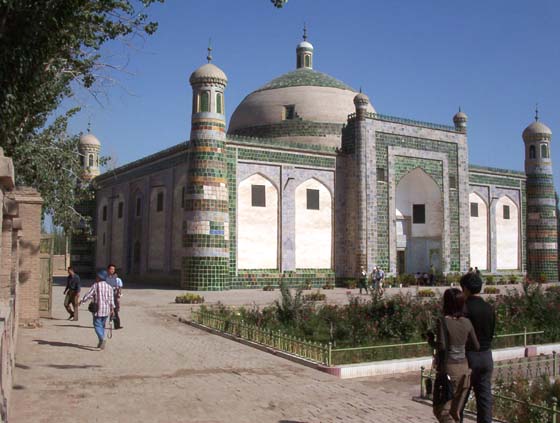 |
25th October All-day trip to Lake Karakul. Back
in time for showers etc at hotel and a late flight to Urumqi. Stay at Holiday
Inn Urumqi.
From Kashgar the Silk Road splits to go over the mountains, one branch into
modern Kyrgystan, the other over the high Pamir into Pakistan. In recent years
that route has been turned into a modern motor road, the Karakoram Highway.
This crests at over 4000 metres, and so isn’t open all year. It will, in fact,
close only weeks after our visit, and already winter will be descending from
the peaks. Here we are close to the second highest mountain in the world, known
in the West as K2 or Mount Godwin Austen, at 8,11 metres. It seems fitting to
complete a tour of the Silk Road in China by retracing the steps of the traders
along what is now the Karakoram highway to the peaceful Lake Karakul, where the
caravans gathered their strength for the final push over the high pass and down
into modern Kashmir. The road initially crosses the plain past villages and
small towns before winding up a valley through some spectacular scenery to the
lake itself at 3,600 metres, as the symbolic end to our journey. The Silk Road
continues as it has done for many centuries and on to many other lands and
peoples, but that’s perhaps a journey for another time. |
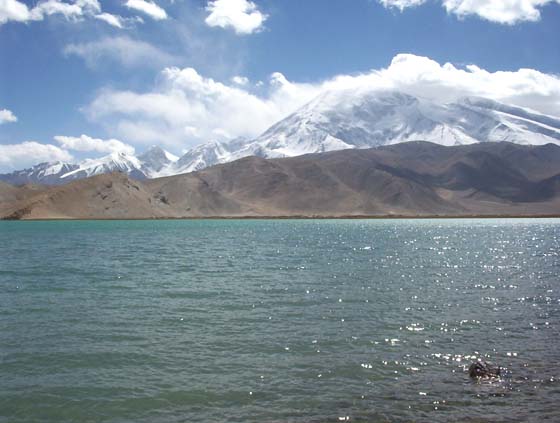 |
| picture: lake Karakul with High Pamir in the background. The lake
is at 3,600 metres, the peak over 6,000 metres high.
We return to Kashgar for freshening up, dinner, and a late flight back to
Urumqi.
|
26th October Sights in and around Urumqi,
depending on time of flight to Beijing, but probably White Poplar Gully. Flight
back to Beijing. Stay at Beijing Hotel.
This is a difficult day to predict, as so much will depend on the time of the
Beijing flight, and indeed the time of getting back to Urumqi from Kashgar,
which may well be the small hours of the morning. If there is enough amount of
time left after a reasonable amount of sleep we will probably go to White
Poplar Gully, an almost Alpine area some 40 miles from Urumqi for walking,
looking at waterfalls and generally winding down. |
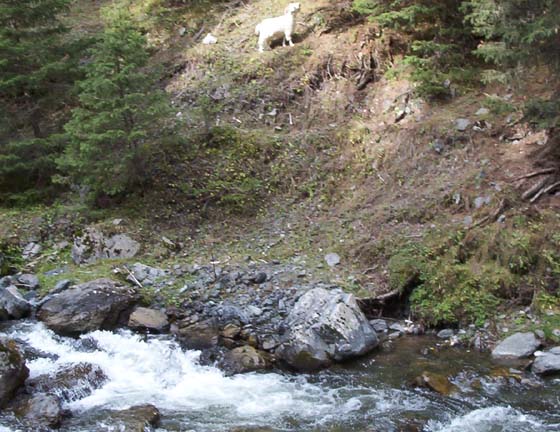 |
| Picture: White Poplar Gully, with pashmina on the hoof!
27th October Relax for the day in Beijing. Stay at Beijing
Hotel
After this amount of travel a day to relax, do some last minute shopping in
Wangfujing or the Silk Market before the flight home. Obviously for the
tireless there are many other things to do in and around Beijing and advice
will be available.
28th October Morning at leisure until departure for Capital
Airport. Flight back to London with Air China CA938 14:05, arrive London
Heathrow 17:50 same day.
“Morning at leisure” is probably only a couple of hours, unless you have a very
early breakfast, as we will need to be at the Capital Airport by about 12.00 at
the latest, thus leaving the hotel about 11.00. A last-minute stroll in
Tiananmen Square, maybe, or the last last-minute souvenir. Remember to keep 90
RMB each for the airport tax, and have a good flight home!
|
|
|
|